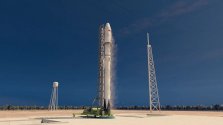One thing to note is that a good chunk of China's launches are of small to medium scale rockets that can carry tiny payloads, if you look at total mass to orbit, China falls even further behind.
Anyway, the important thing here is to focus on reusability. Which right now, looks like the chinese private space sector looks to be closer to developing, faster than the state launch service providers, so I hope that they don't get shafted in favor of long march rockets. Which I mean by that is that it seems that CALT's answer to megaconstellations and SpaceX is just mass production of proven expendable rockets.
The country is constructing an unprecedented rocket assembly plant capable of producing 50 Long March 8 rockets a year, according to scientists involved in the project.
Once completed next year, the mega factory on the tropical island Hainan will nearly double China’s annual launch capacity – already one of the world’s largest.
It's basically their plan for launching their own megaconstellation without resuable rockets, just scale costs down via economy of scale and an already mature technology and rocket . 50 additional long march 8 rockets a year is impressive, will certainly put a lot of payload into orbit and is intended to replace the aging hypergolic long march rockets but at the same time, it could take the wind out of the private sector's sails. It might seem like a good idea today when there's not a single chinese resuable rocket flying, but that could change very fast in 2-4 years.
If 1-2, or even 3 private companies get their Falcon 9 tier workhorse launching dozens of times a year in 2-4 years, then at best this mega long march 8 factory becomes basically obsolete and useless and that's probably billions of dollars wasted. Considering that the long march 8 isn't designed to be reusable at all, even a more expensive expandable medium lift launcher that a company like Ispace flying a dozen times is more worth it in the long run since that's vauable data and money going to into potentially making said rocket resuable in the future.
At worse, the long march 8 strangles the private sector in it's crib by taking most of the launch contracts in the next 2-4 years, espically if they are given speical treatment seeing as they're a government rocket. This is worrying because we're still in the early stages of the chinese private space sector, none of the private companies have reused a rocket yet, some haven't even launched a liquid fueled rocket yet, most of their resuable rockets are going to be pretty small and expandable at first, their production costs at going to be pretty high due to still sorting out their supply chain and techologny and doing R&D, as compared to an already mature rocket techologny like the long march series. If they are going purely at this via free market competition and launch costs, the long march rockets win in the short term, if they're bias towards the long march rockets because they're both government organisations, than it's even more titled towards the long march 8.
And considering the amount of money needed in this field and the cost of developing new technology and scaling up their production facilties, this private companies have to win a lot of contracts to sustain and upgrade themselves, they can't be thrown the scraps that CALT and CASC can't be bothered to eat. They don't have Elon's large pool of money, fame and Starlink business to support themselves, and they can't venture much outside of the domestic launch market like SpaceX can. The majority of the launch contracts should go to the most promising companies espically in such a critical time, until they develop enough to stand by themselves. I hope that China recogonzies this and gives the appropriate amount of support to the private sector.





